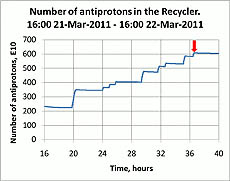Recycler achieves new stashing record
 |
|
The red arrow in the plot above points to a new record number of antiprotons, 608 x1010, stored in the Recycler as of March 22, 2011.
|
A group of employees from Fermilab’s Accelerator Division took advantage of unexpected downtime in the accelerator complex this week after a lightning strike damaged a magnet. Fermilab’s Main Injector and Recycler Department, led by Ioannis Kourbannis, used part of the two week shut down to test the Recycler’s storage capability.
Although the Tevatron was down, the Recycler, the storage ring that holds antiprotons, continued to accumulate the particles. When it became clear that it would take some time to fix the magnet, Cons Gattuso, run coordinator, decided to see whether the Recycler could hold a larger than usual number of antiprotons.
The transfers were stopped at the peak number of 608 x1010, which surpassed the previous record of 540 x1010 set on March 18, 2010.
Normally, explained Sasha Shemyakin, Recycler Department group leader, the group would stop transferring antiprotons at about 500 x1010 out of fear that the beam would become unstable or the beam’s lifetime would degrade.
“We were delighted to see that the lifetime stabilized at the level of 650 hours, which is good for normal operation,” Shemyakin said. “After making several measurements to determine the lifetime in various conditions and to test the procedure of preparing the antiprotons for extraction, we are pretty confident that the Recycler can effectively handle 600 x1010 antiprotons.”
The new record was made possible through the optimization of the Recycler’s performance and improvements in electron cooling. The improvements allowed the Recycler to lose less beam, and Shemyakin said, gave them the idea that boosting the number of antiprotons might be possible.
“The efforts of the entire Accelerator Division to increase the antiproton production led to this record,” Shemyakin said.
-- Rhianna Wisniewski
|